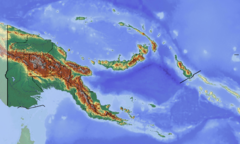Kilu Cave
| Alternate name | Site DJA |
|---|---|
| Location | Autonomous Region of Bougainville, Papua New Guinea |
| Region | Buka Island |
| Coordinates | 5°18′28″S 154°34′44″E / 5.30778°S 154.57889°ECoordinates: 5°18′28″S 154°34′44″E / 5.30778°S 154.57889°E |
| Altitude | 8 m (26 ft) |
| Type | limestone rockshelter |
| Length | 17 m (56 ft) |
| Width | 33 m (108 ft) |
| Height | 4 m (13 ft) |
| History | |
| Periods | , Holocene |
| Site notes | |
| Excavation dates | 1987 |
| Archaeologists | Stephen Wickler |
Kilu Cave is a paleoanthropological site located on Buka Island in the Autonomous Region of Bougainville, Papua New Guinea. Kilu Cave is located at the base of a limestone cliff, 65 m (213 ft) from the modern coastline. With evidence for human occupation dating back to 29,000 years, Kilu Cave is the earliest known site for human occupation in the Solomon Islands archipelago.
Before the discovery of Kilu Cave in 1987, the earliest sites showing evidence for human occupation in the Solomon Islands archipelago were Lapita sites dating back to around 3,000 years old. However, archaeologists had long believed that human occupation in the Solomon Islands occurred much earlier, based on linguistic and anthropological evidence.
During the coldest part of the last Ice Age (28,000 to 18,000 years ago), Buka Island was part of a much larger island, Greater Bougainville, which connected the present-day islands of Buka, Bougainville, Shortland Islands, Choiseul, Santa Isabel and Nggela into one large, contiguous island; this large island was narrowly separated from Guadacanal. At its maximum, Greater Bougainville would have had a total land area of around 46,400 square kilometres (17,900 sq mi).
Reaching Kilu Cave required crossing the Wallace Line, reaching the Sahul and making further sea crossings to reach Greater Bougainville. Archaeologically, the people at Greater Bougainville appeared to live in relative isolation after arriving at the island, with the isolation possibly punctuated by the external introduction of Phalanger orientalis and Canarium indicum. This relative isolation ended with the arrival of the Lapita people.
Kilu Cave was first occupied during the from around 28,000 to 20,000 BP, and after a hiatus, reoccupied more intensively during the Holocene from around 9,000 to 5,000 BP. The hiatus in occupation was most likely due to changes in the sea level that left Kilu Cave far away from the coastline. Some post-Lapita Buka phase pottery was also found at Kilu Cave in its upper layers after around 2,500 BP.
...
Wikipedia

